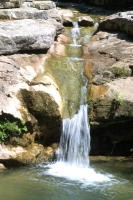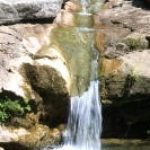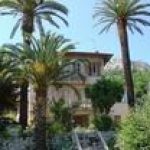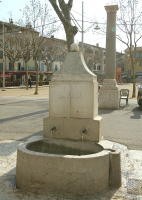
The many fountains bear witness to the importance of the presence of water, so precious to the famers and the people, and for so long an object of envy and conflict. The water of Vence is so highly regarded that you can see lines of people waiting their turn to fill bottles and jars for their own consumption.
The Springs
Firstly, the best known: the Foux. At the start of the Chemin des Salles it is possible to go down to the Lubiane by a path named “de la Source”. It is there that you find the source of the Foux, near an 18th-century bridge. The spring has been used since Roman days – it is mentioned in a text from the year 98. From the 1st century A.D. there was an aqueduct from the source of the Foux, which supplied water to the town and its baths. The town was surrounded by a ditch filled wsith the water (except on the north side where the ramparts are sheer. The spring of la Foux, canalised by the Romans, has served the people of Vence for nearly 2000 years, both for consumptionand houshold use, and even for irrigation. It feeds the town’s fountains today.
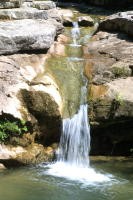
It is a cool water of high quality. It has a low mineral content and is poor in sodium. It is therefore recommended for salt-free diets. It also has diuretic benefits. History states that Poppaea, wife of Nero, whose health was not strong, came to take the waters of Vence, and left in good health. In the 3rd century the emperor Gallienus sent his son. All of this has contributed to the fame of our water.
The Riou. More discreet, more domestic, the water from the tap, is the water from the Riou and from the Sourcets. Access to these springs is now banned by municipal decree “to preserve human life from exposure to danger on the rocks”. The Riou spring has been piped from 1870. In view of the population increase, the Riou is augmented these days by the Gravière, from the Cheiron, to supply the centre of Vence. The Lauron, which already supplies a number of communes (Roquefort les Pins, La Colle sur Loup), augments the Riou for the lower part of Vence. The higher part of the town is supplied entirely by the Gravière.
The fountains
Our circuit begins att the two fountains of the Place du Grand Jardin. The first, near the Marseille column, was originally near the ‘Basse Fontaine’, but was moved to help the tarffic. Here it is perfectly placed, and serves walkers as well as the vegetable-and-flower-sellers of the Place.
On the other side of the road is another fountain. The water flows from a Provençal pottery jar in the centre. Both fountains are made of stone from la Sine.
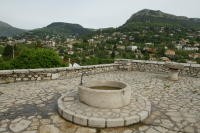
Continue to the Place du Frêne. Pass the Château de Villeneuve – Fondation Emile Hugues, by the ash-tree which has stood there since the days of François 1st. Go on to the end of the small square to the Belvedèr, where there is a magnificent panorama of the Baous, the Matisse Chapel and the valley of the Lubiane. In the centre is a fountain, the circular basin of which is a baptismal font from the 9 th century.
Go down the Rue du Docteur Binet. On the right you will see one of the gates of the town – the Portail Levis (drawbridge). Opposite, on the left, take the little road, rue de la Fontaine Vieille. A fountain used to flow by this road. The archives say little, except that this spring was capricious, disappearing from time to time, needing works to bring it back again. After several metres, on the left, you see it behind a grille. Keep straight on and take the first on the right – you have reached the Rue Henri Isnard.
Follow the Rue Henri Isnard, to the Place Frederic Mistral. There is a little fountain beside the Chapelle des Pénitants Blancs. Against the chapel is a plaque in homage to the Provençal poet; on it are engraved several verses by Mireille. Belong that is a stone bench which comes from the garden of the former seminary of the Avenue Toreille. Keep straight on towards the Avenue des Poilus to the lavoir (washhouse) on the left at the corner of the Rue Elise.
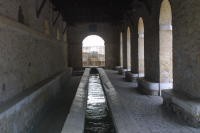
The alignment of a fountain and a lavoir is typical of Provençal villages. The lavoir of Vence is an example. It was built in 1811 at a place where the canalised water had for long served for domestic use. It was modified in 1832n and the lavoir, as you see it today, dates from 1861.
The rectangular basin is the part most used. Its size reflects that of the population of the commune. The length and width were calculated so that each washerwoman had a space of about 80 centimetres. At the lavoir there was a battle to have the best place, near the tap where the water was clean. The last, at the end of the lavoir, had the dirty and water of the others. If all was well, those who were rinsing their washing look the places at the top, where the water was clean, while those who were washing took the places lower down.
Still going away from the town centre, by the Avenue des Poilus, you arrive at the Place Jean Moulin. There waqs formerly a level crossing of the Chemin de Fer de Provence railway. You see the river Lubiane flowing under the viaduct, and on the right are the remains of an old mill. In the last century there were seven mills along the river.
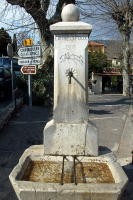
At the corner of the Avenue Marechal Joffre and Henri Giraud there is a little fountain which dates from 1903. Going up Avenue Giraud, at the corner of the Avenue des Alliés, there is another fountain, very simple but fixed to the wall of one of the oldest chapels of Vence, that of Saint Crépin. Continue along the Avenue des Alliés, take the Avenue Humbert Ricolfi. On the right is a fountain, beside the Chemin de Clairefontaine.
By this path you can reach the heights of Vence and the source of the Foux. The walk, signposted, joins the Chemin des Aspras. You follow this path to the Chemin de l’Ormée. There, there is a superb panorama over the town and the coast. Turn to the right, and reach the Chemin de Roland, which you climb to the left. Having arrived at the Chemin des Salles you descend to the right to the Chemin de la Source. You go to the end of this path. There, close to an old bridge and a farm, is where the Foux gushes out. The excess which is not canalised flows into the Lubiane,which has its source not far from there.
You leave this spot by the Chemin de la Source, as you arrived. However, do not take the Chemin des Salles, but descend to the left until you reach the most beautiful of the fountains outside the town. Installed in the 1960s, it is decorated by an engraving on marble by the artist Didier Bereny. Its water flows into a small square stone basin with a wrought iron grille and a blue ceramic background. An ideal thirst-quenching halt during the return walk. Opposite this fountain turn to the left by the Chemin de l’Ormée, then return by the Chemin des Aspras and the Chemin de Clairefontaine.
Return to the town on the Avenue du Marechal Foch. On the right, beside the Lycée Henri Matisse and the Domaine de la Conque, a retirement home for war widows, there is a little fountain dating from 1932. Continue along the Avenue Foch to the Place du Marechal Juin. Turn right towards the Boulevard Emmanuel Maurel. There is a new fountain beside the Chapelle Sainte Anne.
Go down the Chemin Sainte Anne on the left, cross the Avenue Emile Huges, go up the steps, then to the Rue du Pavillon. Take the first little road to the left, the Rue Marie-Antoinette. Opposite us, beside wide stone steps which go up to the Chapelle des Pénitants Blancs, is a little fountain.
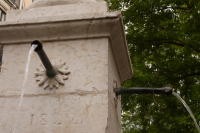
Go back down the Avenue de la Résistance, then along the Avenue Marcelin Maurel, and you arrive at the Place Anthony Mars, in front of a large fountain: the Fontaine Basse. This fountain dates from 1822, and we owe it to the architect Etienne Goby. Its predecessor dated from 1539. It served as a water-trough for animals returning from the fields or for travellers’ horses. It consists of a column cut from a single piece of stone, surmounted by a sphere. This rests on a cube from which flow four jets of water into a basin in the shape of a four-leafed clover. It is made of stone from la Sine.
Going down the Avenue du Colonel Meyère, opposite the médiathèque/library and the Chapelle Saint-Pons is a small fountain decorated with a ceramic entitled “Life”.
Return to the Fontaine Basse. Enter the historic centre by the Porte de Signadour, follow the Rue de l’Hôtel de Ville to the Place Surian. In front of the former Hôtel de Ville, called the “Maison du Saint-Esprit”, is a small recent fountain.
Continue along the Rue du Marché towards the Place du Peyra. There you find the Fontaine Haute (as opposed to the Fontaine Basse on the place Antony Mars). This fountain, more commonly called the Fontaine de Peyra, dates from 1822, and is by the architect Etienne Goby.
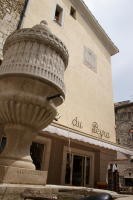
The first Fontaine du Peyra dated from 1439, and was the work of Ribellini. The predecessor of the present one dated from 1578. It is a circular fountain, with a column. The water flows from four jets and falls into a basin whose height allows animals to quench their thirst. The sculptures were inspired by the style of Louis XIV. We see flutes and grooves, an interlaced belt, and, at the top, a pine-cone. Large leaves of water, Empire style, decorate parts of the basin. The Fontaine Haute and the Fontaine Basse were the only supplies of drinking-water before the canalisation of the Riou in 1886.
At the side are two smaller fountains. One, in stone, is directly on the ground, in front of the entrance to the museum bookshop. The other is on the Porte du Peyra; above it is show, the analysis of the water of the Foux.
This is the end of the “water walk”. From the most modest to the most imposing of the fountains it provides many opportunities to discover, or know better, several facets of our town.
- Agent de Cuisine et d’entretien en crèche (H/F)
Temps plein 37h30/semaine avec RTT CDD de 2 mois à compter du 8 janvier 2026 MISSIONS : – Assurer la présentation et distribution des repas et goûters dans le respect des règles d’hygiène en restauration collective. – Nettoyer et désinfecter la cuisine, la réserve et le matériel. – Entretenir au quotidien les espaces de repas, […]
- FORMATION AU SECOURISME POUR LES JEUNES
Le Service Jeunesse, en partenariat avec la FFSS de Nice (Fédération Française de Sauvetage et de Secourisme), propose une formation complète pour apprendre les gestes qui sauvent ! Au programme : – Entraînements sur cas pratiques – Passage de la certification PSE1 – Possibilité ensuite de participer à des postes de secours lors d’évènements culturels […]
- GESTION DE L’ESPACE DE REEMPLOI DE LA DECHETTERIE : APPEL A CANDIDATURE
Une Consultation est lancée pour la gestion du nouvel espace de réemploi de la déchetterie de Vence. Un dispositif de convention permettant d’occuper le domaine public métropolitain pour la gestion de cet espace de réemploi a été mis en place par la Métropole Nice Côte d’Azur. MODALITÉS DE SÉLECTION DE L’ASSOCIATION L’association candidatera par courrier […]
- Exposition Tous à la Chapelle !
Du 13 décembre au 5 janvier à la Chapelle des Pénitent Blancs décembre 2025 Vernissage : samedi 13 décembre à 12H. Tous à la Chapelle V met à l’honneur une sélection d’artistes Vençois venus partager leur univers au cœur des Pénitents Blancs. L’occasion pour le public de découvrir une diversité de regards, de techniques et de […]


